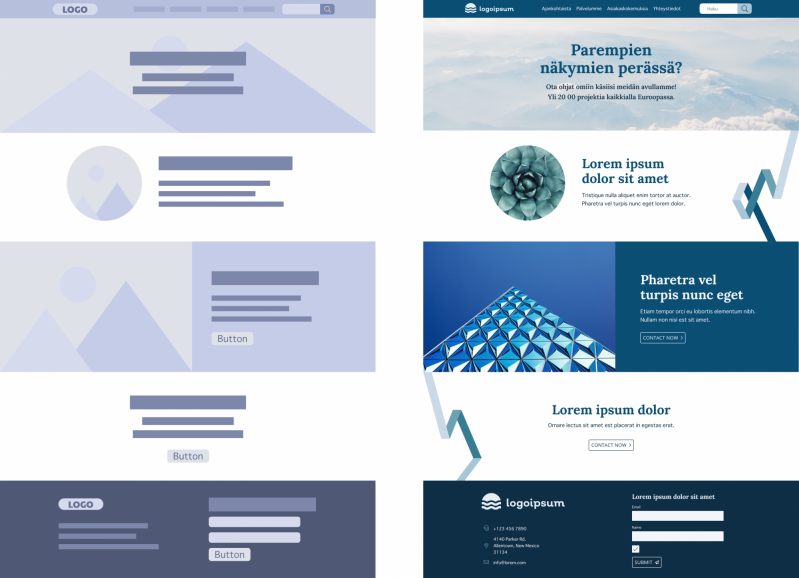Onboarding is the process during which a customer is familiarized with the products or services that a company offers. During the onboarding process, the product or service provider and the customer will go through the customer’s goals together, and the client will be trained and guided so that the goals are met. The smooth implementation of digital marketing tools in an organization relies heavily on a successful onboarding process.
In this article, we’ll go through what happens during the onboarding process of the digital marketing solutions offered by Liana Technologies. We’ll also give you some homework on what an organization should think about even before the onboarding.
You can move straight to the solution you’re interested in by clicking on these links:
1. PR & Media
The onboarding process of a press release distribution solution and a media monitoring tool is relatively easy. The Customer Success Manager assigned to the customer holds 1-2 training sessions in which they’ll go through how to use the tool – in a way that best serves the customer. After this, the customer starts using the tool independently and the responsibility for the customer is transferred to an Account Manager.
It is also always possible to get more help in the form of additional services. For example, if a customer needs to do a more comprehensive media analysis with the help of an expert, Liana's service unit can implement one.
2. Email Marketing
Prior to the onboarding of the email marketing tool, a newsletter template has likely been created for the customer. The newsletter template can be built using the customer's existing visual guidelines, or Liana can plan an entirely new visual look for the emails. Implementing the tool itself with the customer requires about 1-2 training sessions, which are held online by the Customer Success Manager. The training sessions can also be viewed later as recordings.
3. Marketing Automation
Marketing automation, like websites and online stores, is a project product, meaning that the onboarding is a project. The length of the project depends on the scope of the operations and the number of the so-called moving parts. The project will, of course, be managed by a Project Manager.
The project begins with a meeting in which the goals are defined, and by then it would be good to have some kind of an idea of what challenge the automations are going to solve, or what the organization wants to achieve. For example, the goal may be to:
- Get customers to buy a product in a particular cycle
- Sell add-ons and services
- Reduce customer churn
- Manage the customer relationship and add customer value
- Generate leads
- Inform on a continuous schedule
- Share content
Questions to help you get started:
What kind of goals does the company have for next year, for example? How much do you want to invest to achieve them? What kind of development plans do you have? What is the main focus of your marketing? Are you looking to grow? What is the starting point? What is being done or not being done in your marketing right now? What are the barriers or challenges to achieving the goals? Are there any shortcomings in the resources?
In the case of automations, any integrations must always be taken care of before automations can be built. Integrations may be needed for your:
- CRM system
- Booking system
- Event management system
- Financial management system
- ERP system
- Ecommerce solution
- Sales tools
The integrations are implemented either by the automation tool supplier or by the customer company – or they are implemented as a collaboration. Additional integrations always increase the duration of the project slightly, depending on how much work said integrations require.
Once the integrations are in order, the actual onboarding process of automations with the users can begin.
In an automation project, onboarding can be implemented in three different ways depending on the customer organization’s wishes and resources.
If the customer organization itself wants to be the one using the automation tool, then the kickoff meeting includes the customer, Account Manager, Project Manager or Customer Success Manager and, if necessary, an IT person from the customer’s organization.
If, on the other hand, the customer organization wants help with the automations, a Marketing Specialist from Liana will come and help. The marketing expert does the ideation, planning and implementation of campaigns as a service, and can hold monthly meetings, make a goal plan and an annual marketing calendar, and report and review the results with the customer.
The third way is an all-inclusive solution that doesn’t really require onboarding at all, as the customer organization is not trained to use the tool. Liana is responsible for the implementation of campaign planning and the use of the tool. A goal plan and an annual marketing plan are made with the customer and the results are monitored.
4. Websites
Website onboarding is a big project where in addition to the project team and the salesperson, the design team is involved. The project starts with website design. It may be that the look of an existing website is simply updated to comply with the Accessibility Directive, for example, or the whole design process can be started from scratch.
In some cases, it may also be that the whole site is made using a ready-made template, which Liana has created plenty of for the needs of different industries. In such cases, the project is much lighter as the technical design of the page is nearly done already, and a stylish and functional site can be built easily according to the customer’s needs and brand guidelines.
The website project therefore starts with the involvement of the design team. In order for the customer to get a good overview of the website’s design, at least the front page and a subpage will be presented after this step. The look and feel of the mobile version will also be reviewed.

A wireframe is created to show the customer what the finished website will look like.
Once the customer has accepted the visual look of the site – that is, the colors work, the layout meets the customer’s expectations, and the designer has perhaps ensured that the accessibility directive is being followed, for instance – the actual building of the website begins.
A Front-end Developer builds the page. At this point, the Project Manager and the developer will discuss the different stages of the project. The Account Manager will also be informed about the project’s new possible turning points. A Back-end Developer might also be there to create some custom features for the website.
Once the project reaches the stage where the site is roughly complete, the Customer Success Team will hold a user training session, and the different features of the website are reviewed together with the customer.
The customer will add and is responsible for the content of the website, and is also responsible for any translations that are used for the different language versions. The content entry phase is monitored by Liana and the project manager will answer any questions that the client may have during this stage of the project.
Liana Technologies can also help with the website content entry if it’s chosen as an additional service.
When all of the content has been added to the website, it is time to publish it.
5. Commerce
The onboarding process of an eCommerce solution has a lot in common with the onboarding of a website publishing system. However, an online store is an even larger project than a website. It’s also never completed in principle, meaning that the Project Manager can continue to develop the eCommerce site with the customer for a long time and the communication during the project is more intensive.
The eCommerce project also starts at the design stage, just like a website project.
Different integrations play a big role in eCommerce. This is heavily related to the progress of the project, as building integrations can take time, especially if they are customized. At this point, the project may involve a Back-end Developer who will take care of the integrations.
Next, the project goes through very similar stages as website projects: the customer accepts the look of the front page and subpages and the building of the store starts.
User training on adding content is held either remotely or live, and the customer is again responsible for adding the content into the system. However, as noted, the eCommerce project will also continue in the future, and the Account Manager will stay in touch with the customer to ensure that everything is running smoothly. New integrations can also be added over time.
Digital marketing and communication tools are very different in their onboarding requirements. One tool requires simple and quick training after which the client is ready to use it independently. Another tool, on the other hand, might require design, customization, assembly, and even a longer training phase. What they all have in common, however, is that the customer’s specific needs are mapped out and the whole project will be taken on together as a team.
Would you like more information about our digital marketing solutions?



![How to Get Started with Podcasts? [Infographic]](/media/blog/podcast-article/cache/starting-your-own-podcast-article-cover-378x214,c.png)